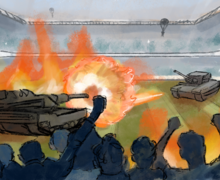Two teams face off in 2012 Global Game Jam
Within the depths of Huntington Hall, 17 avid gamers spent their entire weekend designing games as part of the 2012 Global Game Jam. Given only minimal resources and a 48-hour deadline, the participants were challenged to design and create games for the worldwide event.
Participants split themselves into two groups and went to work, not knowing what they would be creating or if they could even finish on time. Each year, a theme is presented to the participants of the Global Game Jam, and this year’s theme was depicted by a picture of a snake eating its own tail, also known as the ‘ouroboros.’ The two groups frantically looked up the meaning of the mysterious symbol, and both came up with two different ideas for their games.
The first group created a board game called ‘Solstice,’ where players move around a square board, collecting different items and fighting other players.
Eugene Law, a senior environmental resources engineering major at the State University of New York College of Environmental Science and Forestry and one of the designers for the game, said his group looked up the mythology of the symbol to come up with the idea of a game based on seasons.
‘We designed a board game based on the dichotomy of the seasons, where winter and summer are at war and mythological creatures fight each other for supremacy,’ Law said.
The second group created a game called ‘Orbis,’ a digital game in which users can click on stars and planets in space. As the user clicks, the star or planet will either absorb surrounding objects or explode in an attempt to create a new object.
The group used Adobe Photoshop to create the background of the game, as well as 3D modeling software to make the explosions and planets.
After the 48-hour deadline passed, the participants, volunteers and judges were allowed to test the games. Annina Ruest and Andy Fedak, two professors in the computer art program at the College of Visual and Performing Arts, were among the judges who observed the games.
‘It was amazing,’ Fedak said. ‘I was impressed with the quality of work. I wasn’t expecting it to be so good.’
Ruest said she was particularly intrigued by the games, as she teaches gaming at Syracuse University.
‘We were really impressed.’ Ruest said. ‘We’ve judged competitions before, and it was really obvious that both games were really great.’
On Sunday night, the judges voted Orbis as ‘Most Innovative,’ while Solstice won ‘Best Game Play.’ Both games took home the award for ‘Best Visual Design.’ All of the participants and volunteers also voted for their favorite game of the night. Solstice won the ‘People’s Choice Award’ by a narrow margin.
Chris Hanson, assistant professor of English and head faculty organizer for this year’s event, said he was very pleased with the results.
‘It’s been really amazing to see what people produce in such a short period of time,’ Hanson said.
‘I think we learned a little bit from doing it last year,’ said Alan Foley, program coordinator for the instructional technology master’s program.
While only three participants from last year’s event returned, the gamers this year said they really enjoyed their time and look forward to coming back to next year’s Global Game Jam.
‘I wasn’t expecting to have this much fun,’ said Law, one of the ‘Solstice’ designers. ‘But I’d definitely do it again, and I would tell all my friends to come.’
Published on January 29, 2012 at 12:00 pm
Contact Tyler: tagreena@syr.edu





